2010 AUDI S6 tires
[x] Cancel search: tiresPage 253 of 368
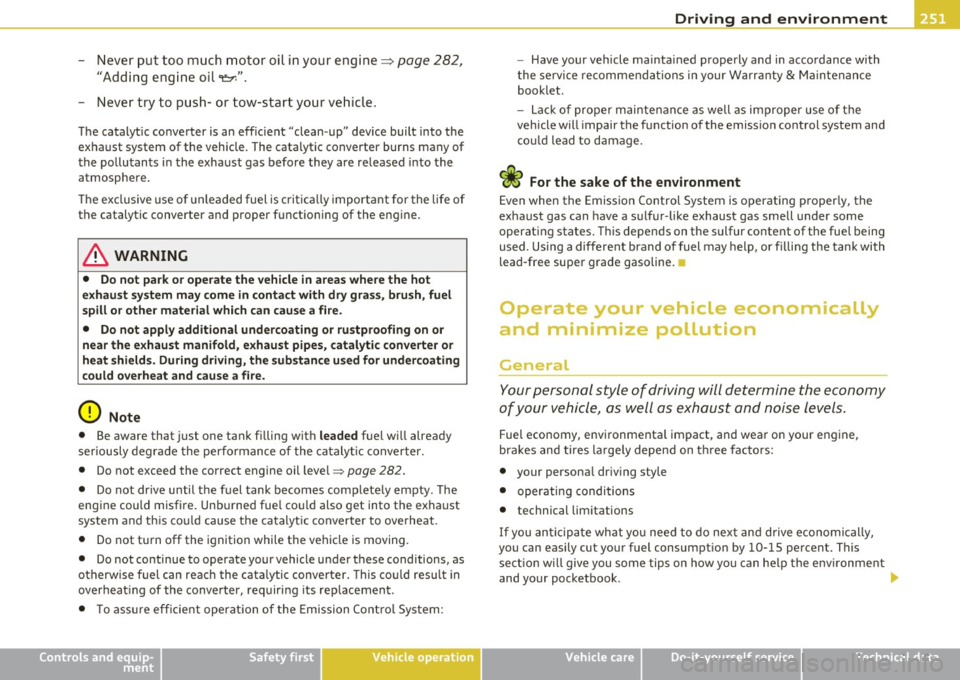
Driving and environment
------------------------------------------------'
-Nev er p ut too much motor oil in yo ur eng ine=:> pag e 282 ,
"A dd ing eng ine o il 't=:r.".
- N ever try to push- or tow-star t your ve hicle.
Th e catalyt ic conve rter is an eff ic ient "clean-up" device built into the
ex ha ust system of the vehicle . The catalytic converter burns many of
t he pollu tan ts i n the exhaust gas be fore they are re leased into the
atmosphere.
Th e excl usive use o f un leaded fuel is crit ic all y import ant for the lif e of
the catalytic converter and proper funct io ni ng of the engine.
& WARNING
• Do not park or ope rate the vehicle in areas where the hot
exhaust sy stem may come in conta ct with dry grass, bru sh, fuel
spill or othe r materi al which can cause a fire .
• Do not apply additional undercoating or rustproofing on or
near the exhaust manifold , exhaust p ipes , catalytic converter or
heat shi eld s. During driving, the sub stance u sed for und ercoating
could o verheat and cause a fire.
0 Note
• Be aware that just one tank filling w it h leaded fuel will already
ser iously degr ade the performance of the catalyt ic converter.
• Do not exceed the correct engine oi l level =>
page 282.
• Do not dr ive until t he fuel tank becomes com plete ly em pty. The
engine could misfire. Unbu rned fue l co uld also get into the exhaust
sys tem and t his co ul d cause t he ca talyt ic converter to ove rheat.
• Do not turn off the ignition while the vehicle is moving.
• Do not continue to operate your vehicle under these conditions, as
otherwise fuel can reac h the cata lyti c conve rter. This co ul d res ult in
over heat ing of the converter, requir ing its rep lacement.
• T o ass ure eff icient operat ion of the Emission Cont rol System:
Controls and equip
ment Safety first Vehicle operation
-
Have your vehicle maintained properly and in accordance with
t he se rvi ce recom menda tions i n your W arran ty
& Mai ntenan ce
booklet.
- Lac k of proper mai nte nance as well as im proper use o f th e
veh icle w ill impair the function of the emiss io n cont rol system and
c o uld lead to d amage.
~ For the sake of the environment
Even when the Emiss ion Contro l System is operating properly, the
exhaust gas can have a s ulfur-like exhaust gas smell under some
operating states . This depends on the sulfur content of the fue l being
used. Using a differe nt brand of fuel may help, or filli ng the tank with
lead-free super g rade gasoline. •
Operate your vehicle economically
and minimize pollution
General
Yo ur p ersonal sty le o f driving will determine the eco nom y
of your vehicle, as well as exhaust and noise levels .
Fuel economy, envi ronmenta l impact, and wear on your engine,
bra kes and tires la rgely depend on t hree fac to rs:
• your persona l dr iv ing style
• operati ng conditio ns
• technical limitations
If you an tici pat e wh at yo u nee d to do nex t an d drive eco no m ic ally,
you can easily cut your fuel consumpt io n by 10-15 percent. This
se ct io n w ill give you s ome tips on how yo u can he lp the env ironme nt
and your pocketbook .
Vehicle care Do-it-yourself service Technical data
Page 257 of 368
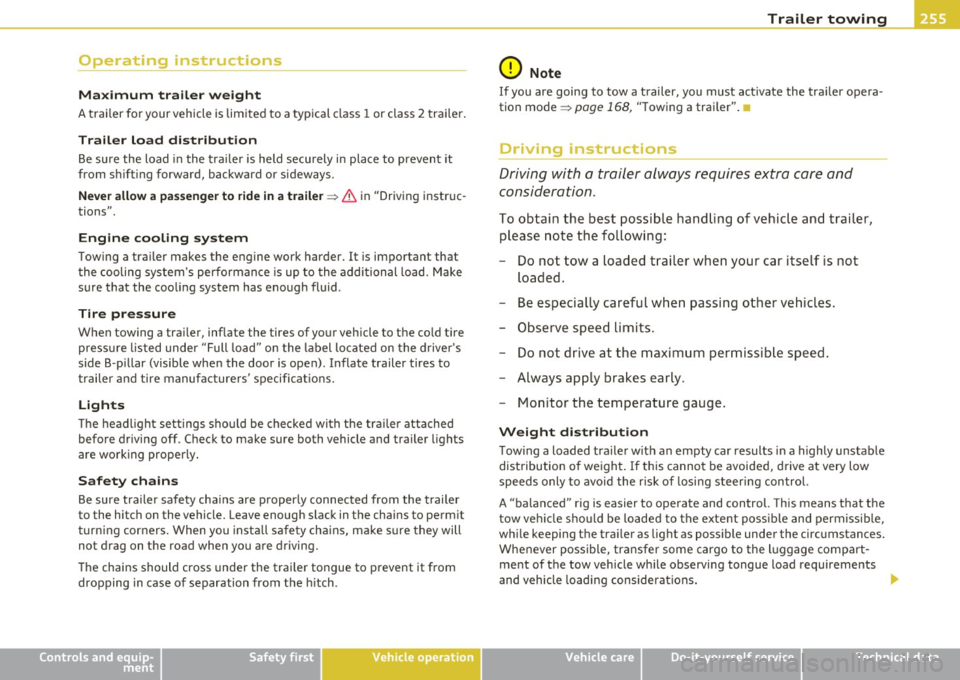
Operating instructions
Max imum tr aile r weight
A trai ler for your vehicle is lim ited to a typical class 1 or class 2 trailer.
Trail er lo ad di stribut ion
Be sure the load in the t ra iler is held secu rely in place to prevent it
from shift ing forward, backward or sideways.
N ev er a llow a pa ssenge r to ride in a traile r=>
& in "Driving instr uc
tions".
Eng ine c ooling s ystem
Towing a trailer makes the eng ine work harder. It is important that
the cooling system 's performance is up to the addi tional load. Make
sure that the cooling system has enough fluid.
Tire pre ssur e
When towing a tra iler, inflate the tires of your veh icle to the co ld tire
pressu re listed under "Full load" on the label located on the d river's
side 8 -pillar (visible when the door is open) . Inflate traile r tires to
t rai ler and tire manufacture rs' specificat io n s.
Light s
The headl ight sett ings shou ld be checked with the tr ailer attached
before driving off. Check to make sure both vehicle and trailer lights
are working properly .
Safety chain s
Be sure traile r safety cha ins are p roperly connected from the trai ler
to the hitch on the vehicle. Leave enough slack in the chains to perm it
tu rning corners. When you install sa fe ty cha ins, make s ure they will
not drag on the road when you are driving.
T he chains should cross under the trai ler tongue to prevent it from
dropping in case of separation from the h itch .
Controls and equip ment Safety first Vehicle operation
0 Note
If you are going to tow a t
railer, you must activate the tra iler opera
tion mode =>
page 168, "T owing a trai ler" .
Driving instructions
Driving with a trailer always requires e xtra care and
consideration .
To obtain the best possible handling of vehic le and trailer,
please note the following:
- Do not tow a loaded trailer when your car itself is not
loaded.
- Be especially careful when passing other veh icles .
- Observe speed limits .
- Do not dr ive at the maximum permissible speed.
- Always apply brakes early .
- Monitor the temperature gauge .
Weight distribut ion
T owing a loaded tra iler w ith an empty car results in a highly unstable
distribution of we ight . If this cannot be avoided, d rive at very low
speeds only to avoid the risk of losing steering control.
A "balanced" r ig is easier to operate and control. This means that the
t ow ve hicle sho uld be loaded to the exte nt poss ible and permissib le,
wh ile keeping the tra iler as light as poss ible under the circumstances.
Whenever poss ible, tra nsfer some cargo to the l uggage compart
ment of the tow vehicle while observing tongue load requirements
and vehicle load ing considerations .
Vehicle care Do-it-yourself service Technical data
Page 262 of 368
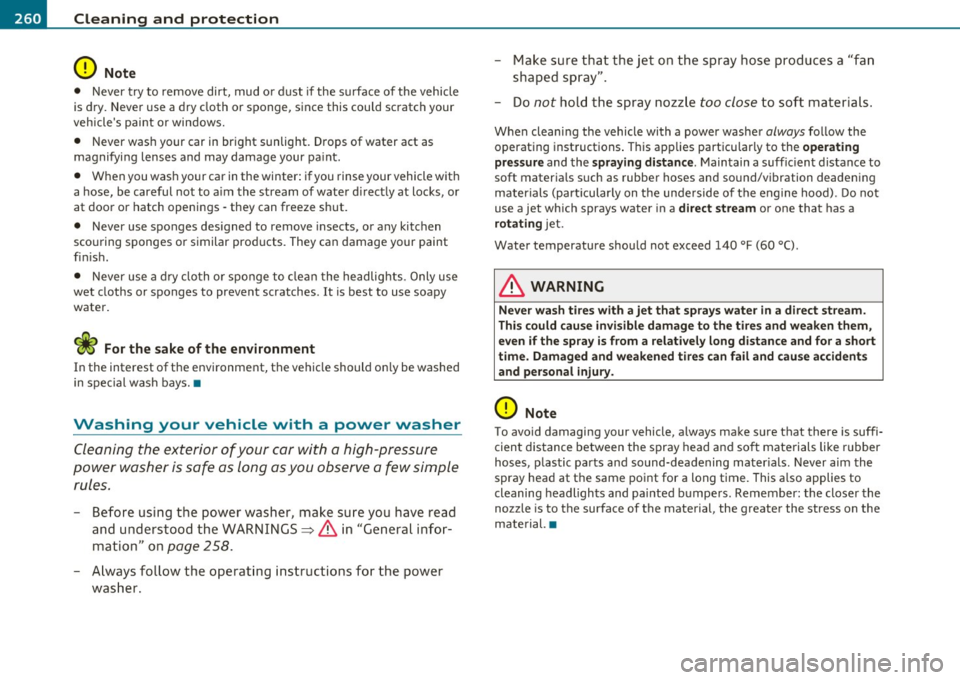
-~_C_ le_ a_n_ i_ n_ g=- a_ n_d___. p_ ro_ t_e _c_ t_ i_o _n ___________________________________________ _
0 Note
• Never try to remove dirt, mud or dust if the surface of the vehicle
is dry. Never use a dry cloth or sponge, since this could scratch your
vehicle's paint or windows.
• Never wash your car in bright sunlight . Drops of water act as
magnifying lenses and may damage your pa int.
• When you wash your car in the winter: if you rinse your vehicle with
a hose, be careful not to a im the stream of water d irectly at locks, or
at door or hatch openings -they can freeze shut.
• Never use sponges designed to remove insects, or any kitchen
scouring sponges or similar products. They can damage your paint
fin ish .
• Never use a dry cloth or sponge to clean the headlights . Only use
wet cloths or sponges to prevent scratches . It is best to use soapy
water.
For the sake of the environment
In the interest of the environment, the vehicle should on ly be washed
in special wash bays. •
Washing your vehicle with a power washer
Cleaning the exterior of your car with a high-pressure
power washer is safe as long as you observe a few simple
rules .
-Before using the power washer, make sure you have read
and unders tood the WARNINGS ~
& in "General infor
mation" on
page 258.
- Always follow the operating instructions for the power
washer. -
Make sure that the jet on the spray hose produces a "fan
shaped spray".
- Do
not hold the spray nozzle too close to soft materials.
When cleaning the vehicle with a power washer always follow the
operating instructions. This applies particularly to the
operating
pressure
and the spraying distance. Maintain a sufficient distance to
soft materials such as rubber hoses and sound/vibration deadening
materials (particularly on the underside of the engine hood). Do not
use a jet which sprays water in a
direct stream or one that has a
rotating jet.
Water temperature should not exceed 140
°F (60 °() .
& WARNING
Never wash tires with a jet that sprays water in a direct stream.
This could cause invisible damage to the tires and weaken them,
even if the spray is from a relatively long distance and for a short
time. Damaged and weakened tires can fail and cause accidents
and personal injury .
0 Note
To avoid damaging your vehicle, always make sure that there is suffi
cient distance between the spray head and soft materials like rubber
hoses , plastic parts and sound-deadening mater ials. Never aim the
spray head at the same point for a long time. This a lso applies to
cleaning headlights and painted bumpers. Remember: the closer the
nozzle is to the surface of the material, the greater the stress on the
material. •
Page 295 of 368
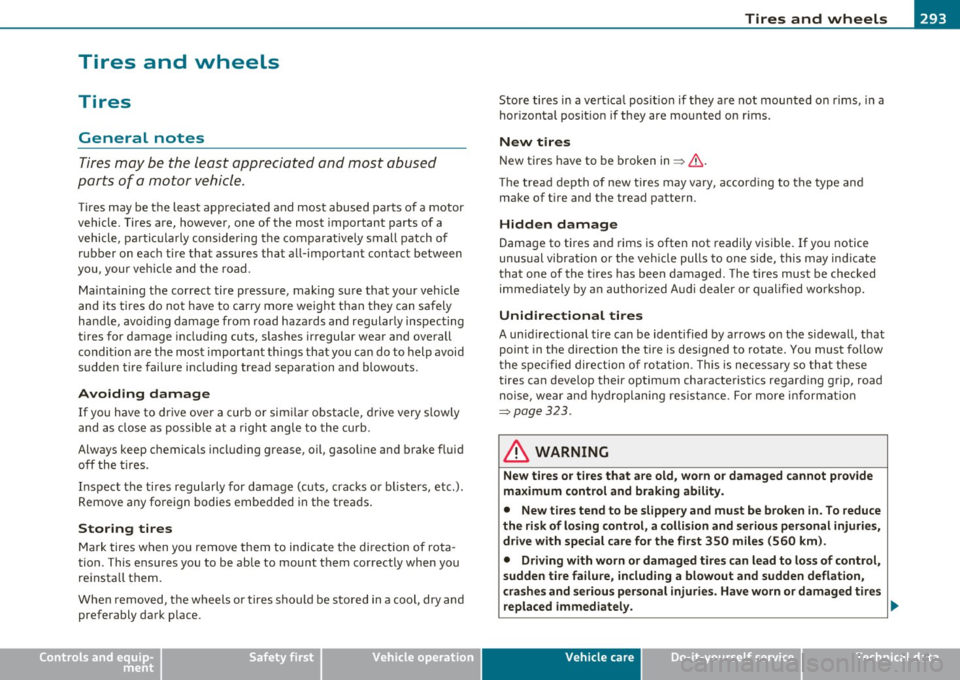
________________________________________________ T_i_re _ s_ a _ n_d_ w_ h_ e_ e_l_s __ _
Tires and wheels
Tires
General notes
Tires may be the least appreciated and most abused
parts of a motor vehicle.
T ir es may be the least appreciated and most abused pa rts of a motor
vehicle . Tires are, however, one of the most important parts of a
vehicle , pa rticul arly conside ring the comparat ive ly small patch of
rubber on eac h tire that assures that all-important contact between
you, your veh icle and the road.
Maintai ning t he cor rect tire pressu re, mak ing su re that your veh icle
and i ts tires do not have to carry more weight t han they can safely
hand le, avoid ing damage from road ha za rds and regularly inspecting
tires for damage includ ing cuts, s lashes irregular wea r and ove rall
condi tion a re the mos t important th ings that you can do to help avoid
sudden t ire failure including tread separation and blowouts.
Avoiding damage
If you have to d rive ove r a cur b or sim ilar obstacle, d rive very slowly
and as close as possible at a rig ht angle to the curb .
Always keep chemicals incl ud ing grease, oil, gaso line and brake f luid
o ff t he t ires .
Ins pect the ti res regularly for damage (cu ts, cracks o r blisters, e tc.) .
Remove any foreign bodies embe dded in the treads.
Storing tires
M ark tires w hen yo u remove t hem to indica te t he d ire ct io n of rota
tion . This ensures you to be ab le to mount them correctly when you
re insta ll them.
Whe n removed, t he wheels or tires should be sto red in a cool, dry and
preferably da rk p lace.
Safety first
Store tires in a v ertica l pos it io n if they a re not mount ed on rims, in a
hor izonta l posit ion if they are mounted on r ims.
New tires
N ew tires have to be broken in=> & .
Th e tre ad d epth of new ti res may v ary, accor ding t o th e type an d
make of t ire and the tread pattern .
Hidden damage
Damage to tires and rims is often not readi ly visible. If yo u notice
unu sual vib ra ti on o r the ve hicle pulls to one side, t his may in dica te
that one of the t ires has been damaged. The tires must be checked
im media tely by an auth oriz ed A ud i d eale r or qual ifie d wor ks hop.
Unidirectional tires
A un id irectional tire can be identified by arrows o n th e sidewall , th at
point in the direct ion the t ire is designed to rotate. You must fo llow
t he s peci fied dire ction o f ro tat io n . This is neces sary so t hat t hese
tires can deve lop their optimum cha racte ristics regard ing g rip, road
noise, we ar an d hy dropl aning res ist an ce. F o r more informat ion
:::>page 323 .
& WARNING
New tires or tires that are old , worn or damaged cannot provide
maximum control and braking ability.
• New tires tend to be slippery and must be broken in. To reduce
the risk of losing control, a collision and serious personal injuries, dri ve with special care for the first 350 miles (560 km).
• Driving with worn or damaged tires can lead to loss of control,
sudden tire failure , including a blowout and sudden deflation ,
crashes and serious personal injuries . Have worn or damaged tires
replaced immediately. _..
Vehicle care Technical data
Page 296 of 368
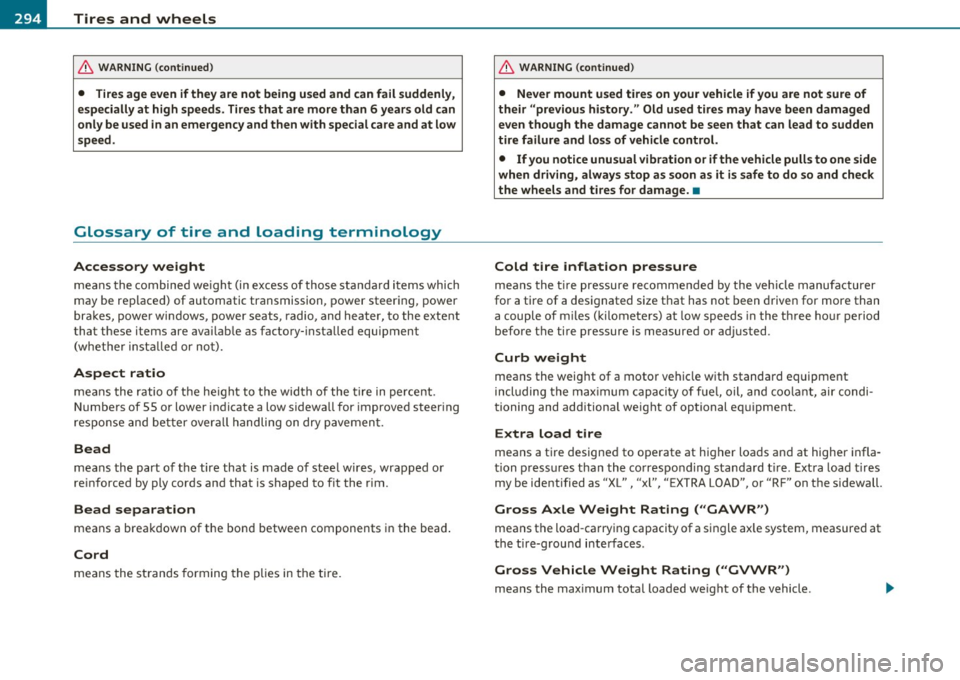
-~_T_ ir_e_ s_ a_ n_ d_ w_ h_e_ e_ ls _______________________________________________ _
& WARNING (conti nu ed )
• Tire s age even if they are not being used and can fail suddenly ,
especially at high speeds . Tires that are more than 6 year s old can
only be used in an emergency and then with special care and at low
s peed .
Glossary of tire and loading terminology
Accessory weight
means the combined we ight (in excess of those sta nda rd items which
may be rep lace d) of automatic transmission, power steering, power
bra kes, powe r w indows , power seats, radio, and heater, to the extent
that these items are avai lab le as factory- installed equipment
(w het he r i nsta lled or no t).
Aspect ratio
me ans the ratio of t he he ight to t he w id th of the tir e in percent .
Numbe rs of 55 o r lower indicate a low sidewa ll for improved steer ing
respo nse an d be tter overa ll handling on dry p avemen t.
Bead
means the part o f the tire that is made of stee l w ires , wrap ped o r
re in forced by ply cords and that is shaped to fit the rim.
Bead separation
means a brea kdown of the bon d between components in the bead .
Cord
means the st rands forming the plies in the tire.
& W ARNING (continued )
• Never mount used tire s on your vehicle if you are not sure of
their "previous hi story ." Old used tires may have been damaged
eventhoughthedamagecannotbeseenthatcanleadtosudden
tire failure and lo ss of vehicle control.
• If you notice unu sual vibration or if the vehicle pull s to one side
when driving, alway s stop as soon as it is safe to do so and check
the wheels and tires for damage. •
Cold tire inflation pressure
means the tire pressure recommended by the vehicle ma nufa cturer
for a tire of a des ignated size t hat has not been driven for more than
a couple of m iles ( kilomete rs) a t low speeds in the t hree ho ur period
before the tire pressure is measured or ad justed.
Curb weight
mea ns the weig ht of a motor vehicle wit h standard equ ipment
including the max imum cap aci ty of f ue l, oil, and coo lan t, air condi
tioning and additiona l weight of optional equipment.
Extra load tire
means a t ire designe d to operate at higher loads and at higher infla
t ion p ressures than the co rrespo nd ing standard t ire. Ext ra load tires
my be identified as "XL", "xl", "EXTRA LOAD", or "RF" on the sidewall.
Gross Axle Weight Rating ( "GAWR ")
means the load -ca rry ing capacity of a s ingle ax le system, measured at
t he t ire-grou nd inte rfaces .
Gross Vehicle Weight Rating ("GVWR")
means the max imum total loaded we ight of the vehicle .
Page 297 of 368

________________________________________________ T_i_re _ s_ a _ n_d_ w_ h_ e_ e_l_s __ _
Groove
means the spa ce between two ad jacen t tread ribs .
Load rating (code)
mea ns the max imu m load th at a tir e is ra te d to c arry fo r a give n infla
tion pressure. You may not find this information on all t ires beca use
i t is no t required by law .
Maximum load rat ing
me ans the load r ati ng for a t ire at th e maxi mum p ermis sib le in flation
pressure for that tire.
Maximum loaded vehicle weight
means the sum of:
(a) Curb weight
(b) Accessory weig ht
(c) Vehicle ca pacity we ight, and
(d) Pro duct ion op tions weigh t
Maximum (permissible) inflation pressure
means the m aximu m cold infla tio n pr essur e to whi ch a t ire may be
inflated . Also called "maximum inflat ion press ure."
Normal occupant weight
means 150 lbs. (68 k ilog rams) times t he num ber of occupants seate d
in t he vehi cle up to the total sea ting cap aci ty of yo ur vehicl e.
Occupant distribution
means d is tribut ion of occ upan ts i n a vehicle.
Outer diameter
means the ove rall d iameter of an inflated new tire.
Overall width
means the linear distance betwee n the exter iors of the s idewalls of
a n in flated tire, in cludi ng eleva tions due to la beling, dec ora tions, o r
protective bands or ribs.
Safety first
Ply
means a layer o f rubbe r-coate d para llel co rds.
Production options we ight
me ans the co m bine d we ight of tho se in stalled regu lar pr oduction
options weighi ng over 5 lbs. (2.3 kg) in excess of t hose standard
i t ems w hic h they replace, not previously considere d in c urb we igh t o r
accessory weight, includ ing heavy duty brakes , ride levelers, roof
rack, heavy duty battery, and s pecial tr im.
Radial ply tire
me ans a pneuma tic tir e in wh ich the pl y cords that extend to t he
beads are laid at substantially 90 degrees to the centerline of the
t rea d.
Recommended inflation pressure
see => page 294, "C old tire in fla tion pr essu re".
Reinforced tire
mea ns a t ire designe d to ope rate at hig her loads an d at higher infla
tion pressures than the co rresponding standard ti re. Reinforced t ires
my be i de ntified as "X L" , "xi", "EX TRA LOA D", o r "RF " on the sidewall.
Rim
mea ns a metal suppo rt fo r a tire or a tire and tube assemb ly up on
wh ic h the t ire beads are seated.
Rim diameter
means nom inal d iameter of the bead seat . If you change yo ur whee l
si ze, yo u w ill have to purchase new tires to ma tc h the new r im diam
eter .
Rim size designation
means r im diamete r and width.
Rim width
mea ns nom inal dis tance be twee n rim flanges.
Vehicle care Technical data
Page 298 of 368
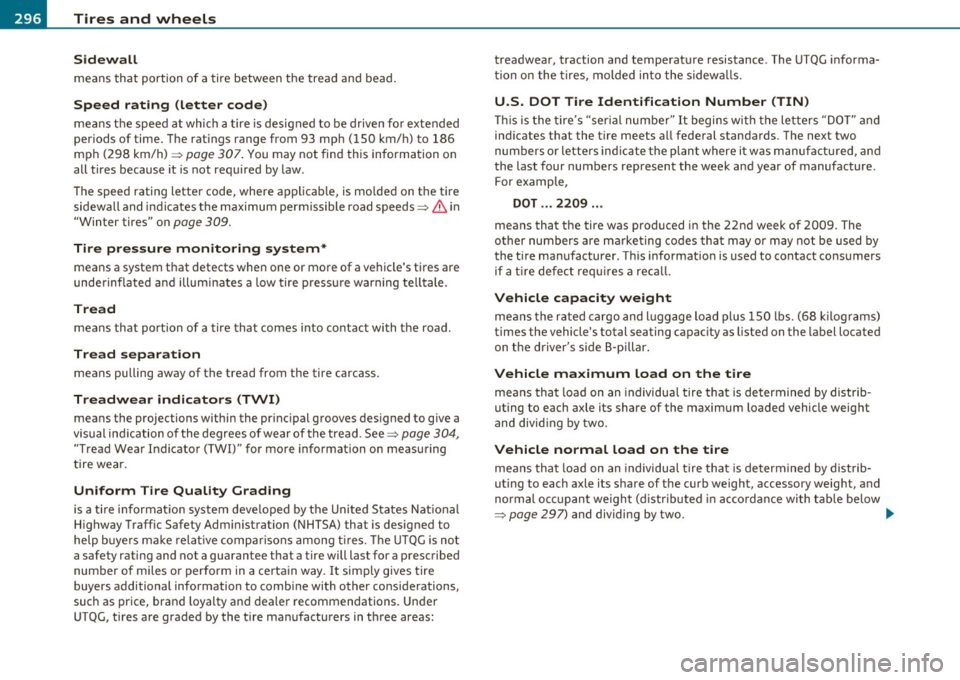
-~_T_ ir_e_ s_ a_ n_ d_ w_ h_e_ e_ ls _______________________________________________ _
Sidewall
means that portion of a tire between the tread and bead.
Speed rating (letter code)
means the speed at which a tire is designed to be driven for extended
periods of time. The ratings range from 93 mph (150 km/h) to 186
mph (298 km/h) =>
page 307. You may not find this information on
all tires because it is not required by law.
The speed rating letter code, where applicable, is mo lded on the tire
sidewall and indicates the maximum permissible road speeds=>
& in
"Winter tires" on
page 309.
Tire pressure monitoring system*
means a system that detects when one or more of a vehicle's tires are
unde rinflated and illuminates a low tire pressure warning te lltale.
Tread
means that portion of a tire that comes into contact with the road.
Tread separation
means pulling away of the tread from the tire carcass.
Treadwear indicators (TWI)
means the projections within the princ ipal grooves designed to give a
visual ind ication of the degrees of wear of the tread. See=>
page 304,
"Tread Wear Indicator (TWI)" for more information on measuring
tire wear.
Uniform Tire Quality Grading
is a tire informat ion system developed by the United States National
H ighway Traff ic Safety Adm inistration (NHTSA) that is designed to
help buye rs make relative comparisons among tires. The UTQG is not
a safety rating and not a guarantee that a tire will last for a prescribed
number of miles or perform in a certain way. It simply gives tire
buyers additional information to comb ine with other considerations,
such as price, brand loyalty and dealer recommendations. Under
UTQG, tires are graded by the tire manufacturers in three areas: treadwear
, traction and temperature resistance. The UTQG informa
tion on the tires, molded into the sidewa lls.
U.S. DOT Tire Identification Number (TIN)
This is the tire's "ser ial number" It begins with the letters "DOT" and
indicates that the tire meets all federal standards. The next two
numbers or letters ind icate the plant where it was manufactu red, and
the last four numbers represent the week and year of manufacture.
For examp le,
DOT ... 2209 ...
means that the tire was produced in the 22nd week of 2009. The
o ther numbers are marketing codes that may or may not be used by
the t ire manufacturer. Th is informat ion is used to contact consumers
if a tire defect requires a recall.
Vehicle capacity weight
means the rated cargo and l uggage load plus 150 lbs. (68 kilograms)
times the vehicle 's total seating capacity as listed on the label located
on the driver's side B-pillar.
Vehicle maximum load on the tire
means that load on an individual tire that is determined by dist rib
uting to each axle its share of the maximum loaded vehicle weight
and divid ing by two.
Vehicle normal load on the tire
means that load on an individua l tire that is determined by distrib
uting to each axle its share of the curb weight, accessory weight, and
normal occupant weight (distributed in accordance with table below
=>
page 297) and dividing by two. .,_
Page 299 of 368

________________________________________________ T_ i_ re _ s_ a_ n_d_ w_ h_ e_ e_l _s _ ....... ffl
Occupant loading and distribution for vehicle normal load for various designated seat ing capacities
Designated seating capacity, num- Vehicle normal load, number of Occupant distribution in a nor
mally loaded vehicle
ber
of occupants occupants
5 3 2 in front, 1 in back seat
Co ld tire inf lation pressure
Tire pr essur e affects the overall handling, performance and safety of a vehicle .
Fig. 216 Tire pressure
label : lo cated o n
dr iver 's sid e B·pillar
Tire pressure generally refers to t he amo unt of a ir i n a tire tha t it
needs it to do its job and safe ly carry the comb ined load of t he entire
vehicle and its contents . Tire p ressure is measured in kilopasca ls
(kPa), the inte rnationa l measur ing unit and in poun ds per squar e in ch
(PSI). Tire press ure is based in part on the ve hicle 's design and load
limit -the greatest a mount of weight that the vehi cle can c arry safe ly
and the tire s ize. The proper tire pressure is frequently refer red to as
the "re commen ded cold t ire inflation p ressure. " Air in t he tires
expands when the tire heats up because of internal friction when it
flexes in use. T he tire press ure is hig her w hen the tir e h as warme d up
than whe n it is "cold." It is the inflation pressure in a "cold" tire that
c o unts. The refo re, you sho uld never let air o ut of a warm t ire to
match "cold ti re inflation pressure " recommendations . The t ires
wou ld then be under in flated and could fail s uddenly.
------------------.. ,::
.(
... TINGc.worv TOTAA. I """" I .... I)(··-) :& NOMBAE DE P\.ACES TOTAi. 4VANT ARAIERE _,, rt-.oomblNd-...glllolOCCIUPll"Matlll~liio.Mn ~a:.u•d •"'M _ .. Uooldt IOUol -~ Ill du dltH-gt11'Nffl N dolt j._11, cibtl-loo !IQ lb.
TIRE SClE COI.O TIN! PMSSUAE PN(U DIMfN 5'0NS NW:S.St()N OU PNEUS A fflOIO
""""
SUOWN'EA'S MANUAl F
INFORMATION
VOIR U MANUEL DU PROJl'RIETAIRE
POUR PLUS OE
RENS£1Gf\1£MENTS Fig . 217 Tire pre ssur e
label
Ma intain ing prope r tire pressure is one o f the most importa nt things
you can do to he lp avoid sudde n tir e fa il u re . Under inflated tires are a
majo r ca use of sudden tire fa ilure . Keeping t ires at the rig ht pressure
is a lso important for safe and responsive vehicl e ha nd ling , traction,
braki ng an d load ca rryi ng.
Tire pressures are particularly impo rtant
when the vehicle is being driven at higher speed s, and then espe·
cially when heav ily loaded even within the permissible load ·
carrying capacities approved for your vehicle .
The recommended tire pressures for your Audi depend on the kind of
t ires on your vehicle and the num be r of passengers and/or amou nt o f
luggage you will be tra nspo rt ing .
The t ire pressure labe l is located on t he dr iver's side B-pilla r. The tire
pressure labe l lists th e recommended cold tire inflat ion p ress ures for
the vehicle at its maximum capacity weight and t ires t hat were on
•
your vehicle at the time it was manu fact ured. _,,,
Vehicle OP-eration Vehicle care Do-it-yourselt service iTechnical data